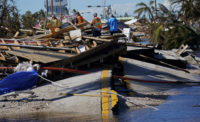Louisiana’s Office of Coastal Protection and Restoration awarded The Shaw Group Inc. the job as project manager on a $360-million project to construct berms along coastal barrier islands to stop the invasion of oil from the BP spill on delicate marshes.
Within 24 hours of signing the contract, Baton Rouge-based Shaw had two bucket dredges on their way to begin moving sand.
The state signed emergency permits for the work late June 2, after it was announced that BP would fund the project as a necessary emergency measure resulting from the Deepwater Horizon spill. Shaw signed the project management contract with the state late June 3 and, by the morning of June 4 met with dredging industry representatives to determine its capacity and availability of equipment.
“If we got a contract yesterday, and today we are actually out soliciting prices on dredging, I think that demonstrates that we are mobilizing very quickly,” says Charlie Hess, vice president of Shaw Environmental & Infrastructure.
At the impromptu June 4 “mini industry day” with the executive director of the Dredging Contractors of America and several dredging contractors, Shaw asked the industry to develop (within 48 hours) a menu of dredging equipment.
“I don’t want to say I need sweet and sour pork, because if only one person has it, the price will be higher,” Hess says. “I want to look at the whole menu of dredging equipment so we can match the prices and selection of equipment best suited for the purpose."
Shaw is seeking equipment for mobilization, demobilization, extracting, moving and placing material, laying pipeline,
Shaw was instructed by the state to engage the dredging to get the work done fast.
Building berms to an elevation of +6 ft. with 1 on 25 slope along the 120 miles of six emergency permitted reaches will require hopper dredges (to excavate and move a lot of material) and cutter head pipeline dredges (for rehandling), Hess says.
“We may use a combination of hoppers and cutter heads to deposit material to bottom-dumping scows,” Hess says. “It’s not just moving material immediately adjacent but, in one case, 50 miles away.”
Hess acknowledged having received queries about the project from “many international companies,” and says he is well aware of concern about the Jones Act being waived.
“We need to realistically look at the capability of the American fleet, and that’s what we’re doing,” Hess says. “That’s what the law says. If it is determined it can’t be done quick enough with that, someone else, not Shaw, will make a decision in the matter.”
The first approved reach of barrier islands to be enhanced will be W9, a three-mile stretch on the western side of the mouth of the Mississippi River that was the first to receive emergency permitting. Hess couldn’t reveal much information about the overall construction sequencing or specific contract awards, but promised to give more details within a week. “We are still in the very throes of the planning effort to make it all happen,” he says.
The state instructed Shaw to engage (specifics to be determined) the partnership of GCR & Associates, Inc., New Orleans and The Bean Companies, New Orleans. The engineering firms have been working on the proposal “for some time,” says Hess, and “the state doesn’t want us to lose the knowledge they’ve created.”
Shaw wouldn’t disclose its contract amount with the state, indicating it is a time-and-materials contract that will include a “series of task orders,” says Gentry Brann, corporate communications director. Also, the scope of work may change if other emergency permits are approved.
Hess acknowledged that construction will be ongoing through hurricane season, but reminded that the berms are designed to be temporary. “We are going to document construction, move on, and they may not last that long,” he says. “This is a mitigation measure to keep oil off certain ecosystems.”
The U.S. Army Corps of Engineers’ emergency permit included objections by numerous agencies and 33 different conditions of compliance.


Post a comment to this article
Report Abusive Comment